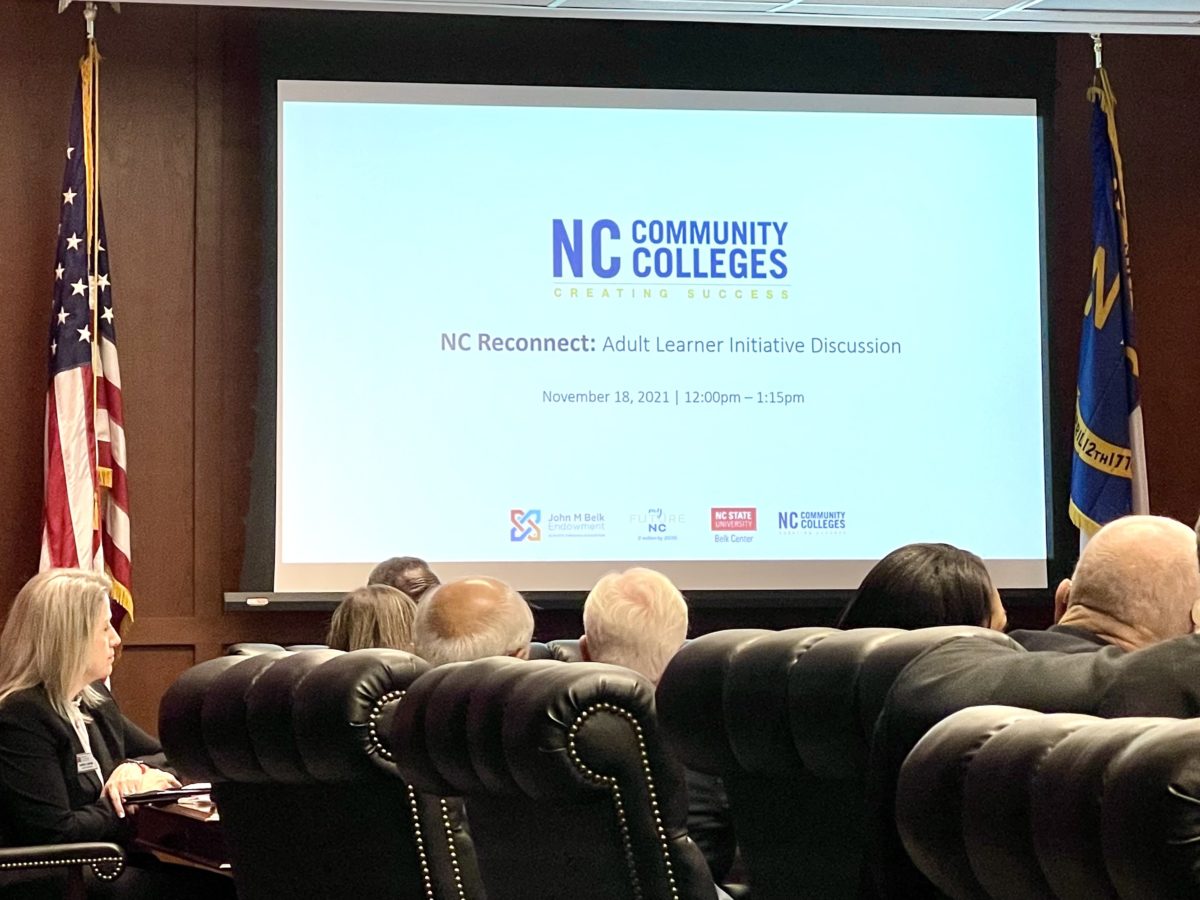
|
|
The agenda of the State Board of Community Colleges’ first meeting of 2022 was packed.
Thanks to the passage of the state budget late last year, the Board approved at its January meeting how to spend portions of its $1 billion investment. They also quickly set their sights on the future with the approval of their 2022-2025 legislative and budget priorities, which they hope will build on this progress.
The Board also conducted a one-year review of President Thomas Stith.
The community college system has had six leaders in about as many years. In the time since Scott Ralls left as president in 2015, the system has had three interim presidents (George Founts, Jennifer Haygood, Bill Carver) and two presidents (Jimmie Williamson and Peter Hans). This makes Stith the sixth leader.
During his time at the helm, the system has secured its largest budget in the last 10 years. At the same time, most of the executive leadership positions in the system have turned over in the last year, leaving the system with several top positions to fill.
The review, which was held in closed session because it’s a personnel matter, lasted almost 3 1/2 hours.
Here’s what you need to know.
Budget allocations
North Carolina finally got a new state budget in November 2021. For the N.C. Community College System, the net appropriation is more than $1.3 billion in each year of the biennium.
Chief Financial Officer Elizabeth Grovenstein explained that this new budget represents an overall increase of 4% and an increase of 12% per full-time student equivalent (FTE), a measure based on the number of accumulated student hours.
For some of that money, the state appropriated a lump sum that the Board was able to vote on how to spend. This included funds for things like an expansion of the adult learner pilot and rural broadband access.
The budget allocates $2 million in the first year of the biennium for programs to serve adult learners, or students who are over the age of 25. Last summer, the N.C. Reconnect initiative launched with five community colleges, and it recently added five more.
According to State Board documents, this additional funding will go toward three main things:
- Providing an additional $50,000 in grants to the 10 colleges in the N.C. Reconnect program.
- Giving colleges in the REACH Collaborative a $25,000 grant to target adult learners from marginalized populations.
- Granting a $1 million contract to Wake Technical Community College to enter into a contract with InsideTrack for all 19 colleges not using the program.
InsideTrack is a nonprofit organization that specializes in student recruitment and retention. The organization works with colleges on recruitment efforts and provides technical assistance.
The state budget also allocated almost $15 million in non-recurring funds to increase broadband access at 25 rural community colleges. This comes after the system allocated about $12 million to do so for 20 other colleges earlier in the pandemic and contracted $750,000 with the Friday Institute to formulate a plan for each college.
With this new funding from the state budget, the initiative to expand broadband access has reached all 45 rural colleges.
This funding will help these rural colleges improve their ability to deliver online learning as well as address increased demands on informational technology, according to board documents.
Different colleges have different needs, but Chief Information Officer Patrick Fleming said the system does its best to get each campus connected. During the previous round of funding, he said each college averaged a $540,000 investment.
The Board also approved a $3 million investment to create a short-term workforce development grant program. Through the program, North Carolina residents can earn up to $750 in grants if they enroll in a noncredit, short-term workforce training program that leads to a credential in a high-demand field.
This particular item comes at a time when the Board is focusing on how community colleges can address workforce needs.
According to the Board documents, “recent polling data from the Strada Center for Consumer Insights noted that 59% of adults considering enrolling in an education or training program prefer non-degree programs.
“Community colleges will be essential to North Carolina’s continued economic recovery as we upskill, reskill, and graduate our workforce,” it reads. “However, unlike traditional academic programs of study, federal financial aid is unavailable for these programs. Establishing the Short-Term Workforce Development Grant Program begins to address this unmet need for the NCCCS and the State of North Carolina.”
The budget also includes $1 million in funds for the system to pay for marketing for the Longleaf Commitment Grant. This program, which launched last year, provides grants for 2020 and 2021 North Carolina high school graduates attending community college. An additional $5 million will provide student support services, Grovenstein said.
You can see all of the community college budget items here.
Three-year legislative priorities
With the latest long session of the state legislature wrapped up and the approval of a state budget, the community college system is already looking to the next three years.
The Board approved its 2022-2025 legislative priorities at its meeting last week. The agenda, which got unanimous support from both the presidents’ and trustees’ associations, addresses the critical needs colleges face, said director of government relations Alex Fagg.
The agenda compares North Carolina to its four neighbors to put the state’s performance and needs into perspective.
For example, the average faculty salary of South Carolina, Virginia, Georgia, and Tennessee is $56,693. To bring North Carolina’s community colleges to that level, according to the agenda, the system needs additional recurring raises of 8% over the next three years.
Richmond Community College President Dale McInnis put it simply for the Board: these priorities are focused on people. They focus on the value of students and staff, and the impact the colleges have on the state’s economy.
“We appreciate the raise our employees received in this recent biennium budget,” McInnis said, “but we also recognize that we’re significantly behind the average faculty salaries that the states around us have, and that puts us at a competitive disadvantage.”
Board members agreed. Lee Barnes, chair of the finance committee, added that North Carolina needs to keep up with places where potential talent could move.
The total three-year request represents a 15.8% increase from the most recent budget.
Many of these priorities align with what the system has learned from its regional visits with colleges. System office staff shared that the top issues colleges care about are recruitment and retention, declining enrollment, resources to meet employer needs, and funding. They said the top requests of the Board were help with funding, advocacy at the state legislature, communication with college leadership, and streamlining functions at the system office.
Board Chair Burr Sullivan and President Stith emphasized that the work with this agenda is not done. They said it will be important to bring this data to legislators directly with “one voice.”
“If we all speak with the same voice and the same data, it’s going to be hard to turn us down,” Sullivan said.
Next, this agenda will be brought to the 58 colleges, and they will be encouraged to host their legislative delegation on campus to emphasize the role they play in their communities.
The Board also discussed a specific provision from the current budget that some members worry could threaten their future funding.
Under the recently passed budget, the state Department of Public Instruction is required to study how it could transition to using a new funding formula.
DPI uses a funding system that measures enrollment through average daily membership (ADM), which is essentially average attendance by each month of the school year. ADM is used to determine how much funding each district gets.
The new budget directs DPI to study a potential shift to measuring attendance using full-time student equivalents (FTE), like community colleges, which could affect how dual-enrollment students like those in Career and College Promise are counted.
“Obviously, any adjustment to that formula could impact our colleges,” Fagg told the Board.
He briefed the Board that system staff have been in contact with DPI and various K-12 leadership across the state and are working “in good faith.”
The next State Board of Community Colleges meeting is Feb. 17-18.





